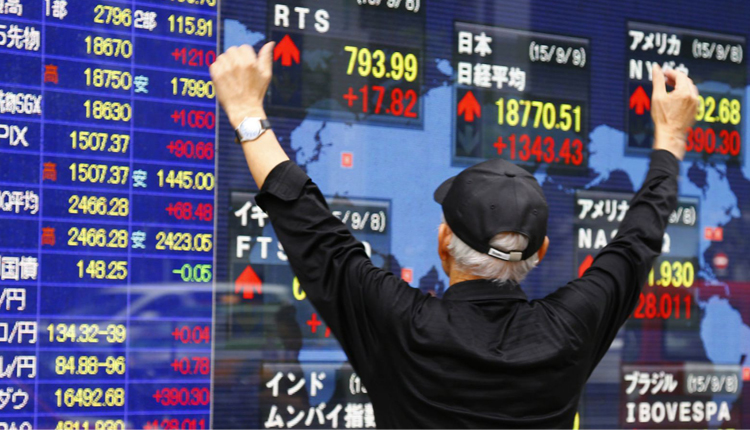Asian markets were subdued in Wednesday afternoon trade as investors kept a close watch on the Chinese yuan amid an escalating trade dispute between the U.S. and China.
The People’s Bank of China (PBOC) set the the official midpoint reference for the yuan at 6.9996 per dollar, which was slightly weaker than market expectations. China’s central bank allows the exchange rate to rise or fall 2 percent from that number.
Mainland Chinese shares were little changed by the afternoon: The Shanghai composite was largely flat, the Shenzhen component rose fractionally and the Shenzhen composite advanced 0.114 percent.
Overall, the MSCI Asia ex-Japan index was lower by 0.11 percent.
The Japanese benchmark Nikkei 225 slipped 0.43 percent, with index heavyweight and robot maker Fanuc shedding 1.72 percent. The Topix index declined slightly.
South Korea’s Kospi, meanwhile, traded fractionally lower as shares of chipmaker SK Hynix rose 2.64 percent. Over in Australia, the S&P/ASX 200 was 0.77 percent higher.
In Hong Kong, the Hang Seng index fell 0.37 percent. Hong Kong-listed shares of Chinese electric vehicle maker BYD dropped 4.88 percent after the company reported that its July sales volume fell about 17 percent, compared to a year earlier. The firm’s Shenzhen-listed shares slipped 0.62 percent.
Chinese yuan
The onshore yuan changed hands at 7.0441 per dollar. Its offshore counterpart, which last traded at 7.0795 against the dollar, is used by foreign investors and banks.
The yuan broke a closely watched level of 7 against the dollar on Monday, sending markets across the globe into a frenzy and leading the U.S. Treasury Department to label China as a currency manipulator.
For its part, the PBOC rejected the U.S. Treasury’s claims on Tuesday, saying that the “United States disregards the facts and unreasonably affixes China with the label of ‘currency manipulators,’ which is a behavior that harms others and oneself.”
Markets are “still grappling with the escalation in trade tension as the yuan depreciated through the key level of 7 to the (dollar), and the US labelled China a currency manipulator,” analysts from ANZ Research wrote in a morning note.
The Chinese central bank’s “stronger-than-expected fixing of the yuan yesterday and reiteration that it won’t seek to competitive depreciate, helped stabilise markets,” the ANZ analysts added.
Those moves came after U.S. President Donald Trump unexpectedly announced late last week that fresh tariffs would be slapped on additional Chinese exports from Sept. 1, intensifying the trade war between Beijing and Washington.
“The decision by (Chinese President) Xi Jinping to allow the (yuan) to dip a little bit is the Chinese equivalent of a tweet, ” Daniel Russel, former assistant secretary of state for East Asian and Pacific Affairs, told CNBC’s “Street Signs ” on Wednesday.
“It’s a signal to the U.S., it’s a signal to Donald Trump. It says: ‘Hey if you want to fight you’re gonna take a few punches,’” Russel added. “China’s not gonna rollover, China’s a big country, a big economy and it politically simply won’t allow itself to be bullied.”
Currencies and oil
The U.S. dollar index, which tracks the greenback against a basket of its peers, was at 97.52, declining from an earlier high of 97.851.
The Japanese yen traded at 106.07 against the dollar after earlier touching a low of 106.47.
The New Zealand dollar dived nearly 2 percent to change hands at $0.6397 after the country’s reserve bank surprised markets and slashed its official cash rate by 50 basis points, to an all-time low of 1 percent.
The Australian dollar changed hands at $0.6698, falling from an earlier high of $0.6782.
Oil prices slipped in the afternoon of Asian trading hours, as international benchmark Brent crude futures declined fractionally to $58.90 per barrel. U.S. crude futures also fell slightly to $53.59 per barrel.
Overnight, the Dow Jones Industrial Average finished its trading day 311.78 points higher at 26,029.52 while the S&P 500 rose 1.3 percent to close at 2,881.77.
The Nasdaq Composite added nearly 1.4 percent to end its trading day at 7,833.27. Tuesday’s gains helped the Dow snap a five-day losing streak, while the S&P 500 and Nasdaq rose for the first time in seven sessions.
Source: CNBC
